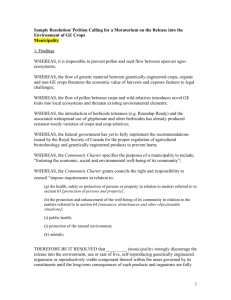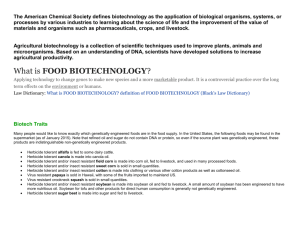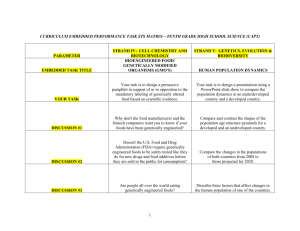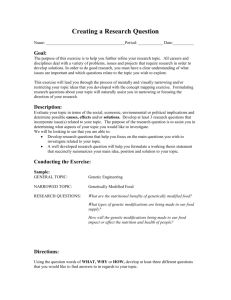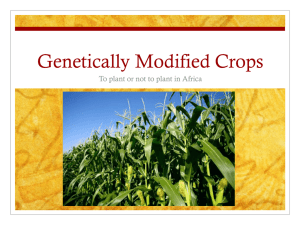Part D - Project Learning Tree
advertisement
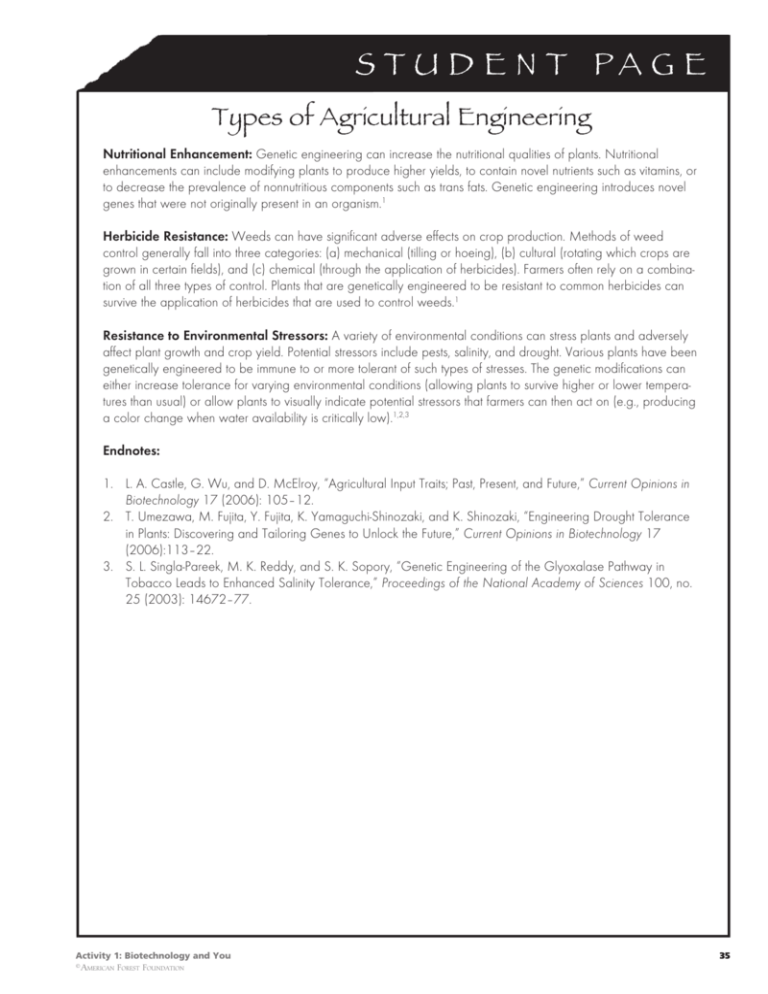
STUDENT P AGE Types of Agricultural Engineering Nutritional Enhancement: Genetic engineering can increase the nutritional qualities of plants. Nutritional enhancements can include modifying plants to produce higher yields, to contain novel nutrients such as vitamins, or to decrease the prevalence of nonnutritious components such as trans fats. Genetic engineering introduces novel genes that were not originally present in an organism.1 Herbicide Resistance: Weeds can have significant adverse effects on crop production. Methods of weed control generally fall into three categories: (a) mechanical (tilling or hoeing), (b) cultural (rotating which crops are grown in certain fields), and (c) chemical (through the application of herbicides). Farmers often rely on a combination of all three types of control. Plants that are genetically engineered to be resistant to common herbicides can survive the application of herbicides that are used to control weeds.1 Resistance to Environmental Stressors: A variety of environmental conditions can stress plants and adversely affect plant growth and crop yield. Potential stressors include pests, salinity, and drought. Various plants have been genetically engineered to be immune to or more tolerant of such types of stresses. The genetic modifications can either increase tolerance for varying environmental conditions (allowing plants to survive higher or lower temperatures than usual) or allow plants to visually indicate potential stressors that farmers can then act on (e.g., producing a color change when water availability is critically low).1,2,3 Endnotes: 1. L. A. Castle, G. Wu, and D. McElroy, “Agricultural Input Traits; Past, Present, and Future,” Current Opinions in Biotechnology 17 (2006): 105–12. 2. T. Umezawa, M. Fujita, Y. Fujita, K. Yamaguchi-Shinozaki, and K. Shinozaki, “Engineering Drought Tolerance in Plants: Discovering and Tailoring Genes to Unlock the Future,” Current Opinions in Biotechnology 17 (2006):113–22. 3. S. L. Singla-Pareek, M. K. Reddy, and S. K. Sopory, “Genetic Engineering of the Glyoxalase Pathway in Tobacco Leads to Enhanced Salinity Tolerance,” Proceedings of the National Academy of Sciences 100, no. 25 (2003): 14672–77. Activity 1: Biotechnology and You © American Forest Foundation 35 STUDENT P AGE Genetically Engineered Plants (Examples of genetically engineered plants that have been marketed or are in late-stage development) Plant Tomato Rice Canola Turfgrass Banana Sunflower Potato Flax Corn Carnation Cotton Dairy Papaya Peanut Soybean Alfalfa Apple Modification Delayed softening,1 increased salt tolerance,1 disease resistance1 Contains vitamin A1 Herbicide resistance,2 contains no trans fats2 Herbicide resistance1 Vaccine delivery (cholera, hepatitis B, and diarrhea),1 increased shelf life,2 pest resistance2 Herbicide resistance,1 mold resistance1 Pest resistance2 Herbicide resistance2 Pest resistance,2 drought resisitence,2 increased energy availability,2 increased nutrients,2 amalyase production (assists in production of ethanol)2 Produces a purple carnation2 Pest resistance,2 herbicide resistance2 Enzyme that curdles milk to make cheese,2 protein that increase milk production2 Virus resistance2 Increased oleic acid content2 Herbicide resistance,2 increased oleic acid content3 Herbicide resistance2 Pest resistance2 Endnotes: 1. “Transgenic Crops: An Introduction and Resource Guide,” Department of Soil and Crop Sciences, Colorado State University, 2004, http://cls.casa.colostate.edu/TransgenicCrops/future.html. 2. “Agriculture Biotechnology Reference Guide,” National Corn Growers Association and U.S. Grains Council, www.ncga.com/files/guide.pdf. 3. O. V. Singh, S. Ghai, D. Paul, and R. K. Jain, “Genetically Modified Crops; Success, Safety Assessment, and Public Concern,” Applied Microbiology and Biotechnology 71 (2006): 598–607. 36 project learning tree Exploring Environmental Issues: BioTechnology © American Forest Foundation STUDENT P AGE Risks, Benefits, and Management Strategies of Genetically Engineered Plants1 Benefits of Genetically Engineered Plants • Increased yield: Genetic engineering can make plants grow faster or produce bigger fruit. • Decreased use of pesticides: Genetically engineering plants to resist certain pests can eliminate the need to use toxic pesticides to protect the crop. • Decrease in energy needed to produce crops: Genetic engineering that results in fewer pesticide applications will result in less energy use by farmers (fewer trips with the tractors, thereby saving fuel). • Increased nutritional quality: Genetic engineering can introduce vitamins and increase protein levels. • Ability to grow in severe or extreme environmental conditions: Genetic engineering can enable some crops to grow in areas that otherwise may not be able to support a crop; extreme conditions can involve high or low temperatures, flooding, or drought. • Increased shelf life: Genetic engineering may result in crops that are easier to store and ship. • Use for human health: Genetically engineered organisms can be used to improve human health such as in the case of edible vaccines. Risks of Genetically Engineered Plants • Introduction of allergenic or harmful proteins into food: Concerns have arisen about increasing the presence of known allergens in novel plant species (such as nut allergies) and about the possible toxicity of transgenic proteins not normally consumed by humans. • Detrimental effect on nontarget species and the environment: Transgenic crops that have insecticidal properties may affect nontarget organisms (e.g., butterflies that naturally feed on the plants). • Potential for increased invasiveness and weediness of genetically engineered crop plants: Genetic engineering of an organism that already possesses invasive traits could exaggerate such traits, potentially causing widespread environmental damage. • Pest resistance: The possibility of pests’ developing resistance to transgenic proteins has generated concern. • Effect on biodiversity: Transgenic crops could hybridize with native plant species, thus decreasing overall biodiversity; cross fertilization through wind-borne pollen or seeds could allow transgenic plants to grow in fields considered free of genetically engineered organisms. Risk Management Strategies • Using male sterile plant lines (no pollen produced) prevents crop cross-contamination. • Making seed viability dependent on the application of a chemical that is not normally found in the environment can prevent seed dispersal. • Using nonfood crops such as tobacco can limit the possibility of genes entering the food chain. • Using greenhouses can contain transgenic crops and their pollen and seeds. • Using phenotypic markers (such as fluorescence) could allow for visual monitoring of transgenes. • Labeling genetically engineered foods will enable consumer choice. • Instituting regulatory requirements will ensure that certain safety considerations are met. • Harvesting crops before they are reproductively mature will limit pollen or seed escape. Endnotes: 1. O.V. Singh, S. Ghai, D. Paul, and R. K. Jain, “Genetically Modified Crops: Success, Safety Assessment, and Public Concern,” Applied Microbiology and Biotechnology 71 (2006): 598–607. Activity 1: Biotechnology and You © American Forest Foundation 37
